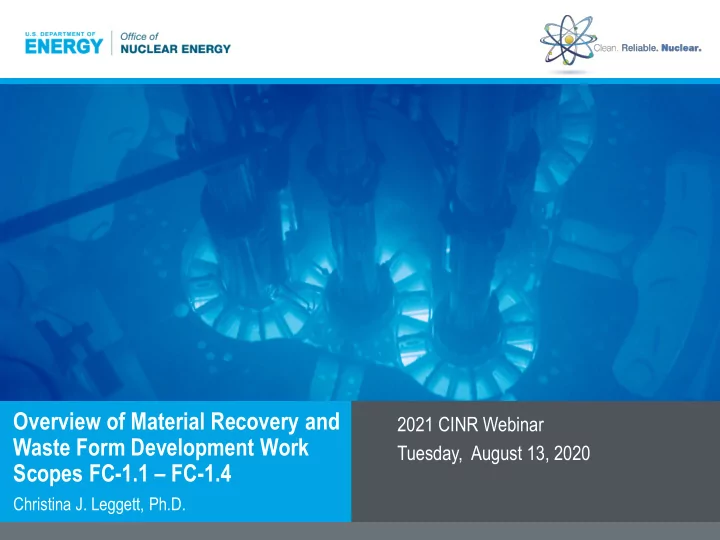

Overview of Material Recovery and 2021 CINR Webinar Waste Form Development Work Tuesday, August 13, 2020 Scopes FC-1.1 – FC-1.4 Christina J. Leggett, Ph.D.
Material Recovery and Waste Form Development (FC-1) Work Scope Overview PROGRAM SUPPORTING: FUEL CYCLE TECHNOLOGIES (FC) ELIGIBLE TO LEAD: UNIVERSITIES ONLY FIVE TOPICS: FC-1.1: INNOVATIVE SEPARATIONS CHEMISTRY FOR HIGH VALUE USED FUELS FC-1.2: NUCLEAR FUEL CYCLE SEPARATIONS CHEMISTRY FC-1.3: UNDERSTANDING, PREDICTING, AND OPTIMIZING THE PHYSICAL PROPERTIES, STRUCTURE, AND DYNAMICS OF MOLTEN SALTS FC-1.4: UNDERSTANDING THE STRUCTURE AND SPECIATION OF MOLTEN SALTS AT THE ATOMIC AND MOLECULAR SCALE FC-1.5: WASTE FORM DEVELOPMENT AND OFF-GAS (Kimberly Gray) CAPTURE 2 energy.gov/ne
FC-1.1: Innovative Separations Chemistry for High-Value Used Fuels Many advanced reactor technologies will use high-assay low-enriched uranium (HALEU) fuels that are significantly more enriched than conventional light water reactor fuels. Used HALEU fuel from these reactors will still contain a large quantity of valuable enriched U-235 that could be economical to recycle. The most heavily researched method of separating uranium, plutonium, and/or minor actinides from UNF is solvent extraction. Other separations methods have been less studied, including selective oxidation, precipitation, and dry processes such as halogenation. Applications are sought that propose innovative or simplified methods of recovering uranium and other valuable actinides from a variety of used nuclear fuels that could contain HALEU. *Funded Up to 2 Years and $400,000 Program Contacts: Federal POC: Christina Leggett, Christina.Leggett@nuclear.energy.gov Technical/Lab POC: Terry Todd, Terry.Todd@inl.gov 3 energy.gov/ne
FC-1.2: Nuclear Fuel Cycle Separations Chemistry Chemical separations processes are used in nearly every stage of the nuclear fuel cycle and for other nuclear applications. These separations typically focus on uranium and plutonium recovery for recycling, but several other valuable isotopes could be recovered. Advanced separations processes and technologies for actinides and other valuable elements may provide additional economic benefits for UNF recycle. Applications are sought that propose innovative research on fundamental coordination chemistry, recovery of actinides and valuable elements from UNF, radiolysis in solvent extraction systems, and computational modeling of solvent extraction phenomena. *Funded Up to 2 Years and $400,000 Program Contacts: Federal POC: Christina Leggett, Christina.Leggett@nuclear.energy.gov Technical/Lab POC: Terry Todd, Terry.Todd@inl.gov 4 energy.gov/ne
FC-1.3: Understanding, Predicting, and Optimizing the Physical Properties, Structure, and Dynamics of Molten Salts Thermodynamic models are needed to predict critical salt characteristics such as melting points, heat capacities, free energies for potential corrosion reactions, and solubilities of fission and corrosion products as a function of temperature and composition. Proposals are requested to better understand, predict, and optimize the physical properties and thermochemical behavior of molten salts. • Goal: To develop and use first-principles molecular dynamics simulations and computational electronic structure methods to model a broader range of chemical evolution and environments. Looking for innovative approaches to • apply molecular dynamics simulations to predict thermophysical and transport properties • build multi-component models for prediction of phase diagrams • develop advanced models to guide experimental efforts to manipulate molten salt thermophysical properties *Funded Up to 2 Years and $400,000 Program Contacts: Federal POC: Christina Leggett, Christina.Leggett@nuclear.energy.gov Technical/Lab POC: Mark Williamson, Williamson@anl.gov 5 energy.gov/ne
FC-1.4: Understanding the Structure and Speciation of Molten Salt at the Atomic and Molecular Scale To understand the effects of structure and dynamics of molten salts on their physical and chemical properties, it is necessary to determine the speciation of salt components as well as the local and intermediate structures at operationally relevant temperatures. We are seeking proposals that use innovative tools and instrumentation to obtain information at the atomic and molecular scale. Goals: (1) to determine the local structure and bonding of chemical species in salt solutions and (2) to develop innovative real-time analytical methods for microscopic and macroscopic property measurements Includes innovative approaches to (1) determine salt molecular structure using scattering and spectroscopic methods, (2) develop novel electrochemistry and spectroscopy methods for in-situ monitoring and predictive modeling, and (3) develop a molten salt optical basicity scale to determine corrosivity and solubility of actinides. *Funded Up to 3 Years and $600,000 Program Contacts: Federal POC: Christina Leggett, Christina.Leggett@nuclear.energy.gov Technical/Lab POC: Mark Williamson, Williamson@anl.gov 6 energy.gov/ne
Complementary Work Scope: NEAMS-2 NEAMS-2: C ORROSION M ODELING FOR M OLTEN - SALT - FACING S TRUCTURAL C OMPONENTS “…Robust modeling and simulation capabilities that can predict the evolution of corrosion in such components at scales of engineering relevance are essential for understanding the implications of design decisions on the service lives of such reactors. Proposals are sought for projects that will develop capabilities for simulating the processes involved in corrosion in alloys relevant for these reactors. Physically realistic models of these processes at the mesoscale are essential, and there must be a clear path to allow the results of mesoscale simulations to be used to inform predictive engineering-scale models. Proposals that address any current capability gaps in this area are welcome…” • FC-1.3 and NEAMS-2 work scopes are complementary: – FC-1.3 work scope: atomic- and molecular-scale modeling of molten salt thermophysical and transport properties – NEAMS-2 work scope: meso-scale modeling of molten salt interactions with structural materials • Currently engaged with the NEAMS team about our work scopes Contact Dave Henderson at David.Henderson@nuclear.energy.gov for more information. 7 energy.gov/ne
Questions? Feel free to contact me at Christina.Leggett@nuclear.energy.gov 8 energy.gov/ne
Recommend
More recommend